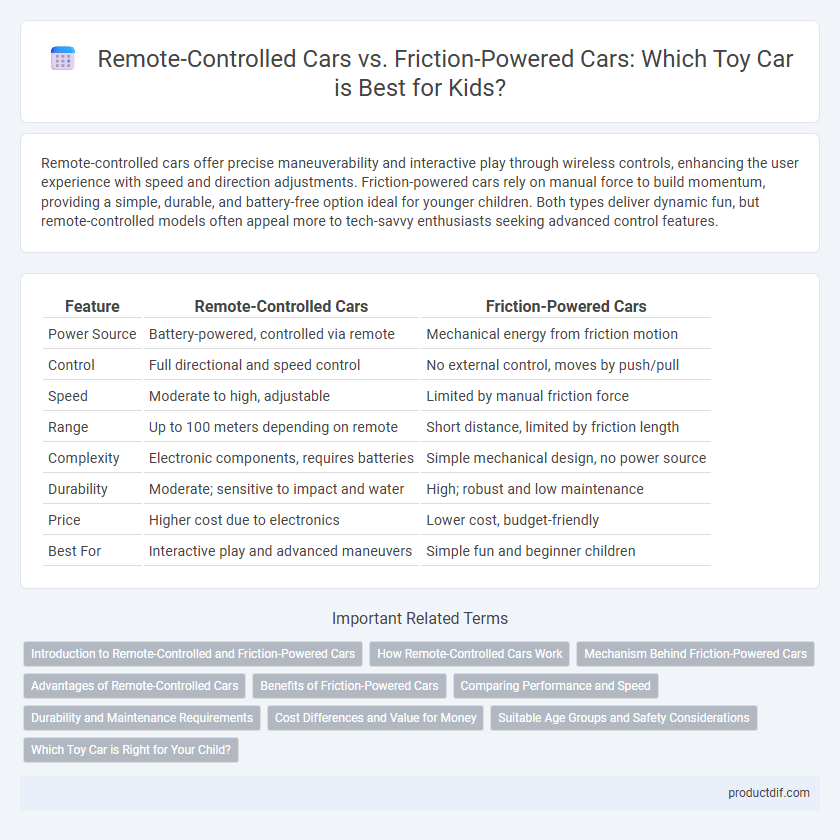Remote-controlled cars offer precise maneuverability and interactive play through wireless controls, enhancing the user experience with speed and direction adjustments. Friction-powered cars rely on manual force to build momentum, providing a simple, durable, and battery-free option ideal for younger children. Both types deliver dynamic fun, but remote-controlled models often appeal more to tech-savvy enthusiasts seeking advanced control features.
Table of Comparison
| Feature | Remote-Controlled Cars | Friction-Powered Cars |
|---|---|---|
| Power Source | Battery-powered, controlled via remote | Mechanical energy from friction motion |
| Control | Full directional and speed control | No external control, moves by push/pull |
| Speed | Moderate to high, adjustable | Limited by manual friction force |
| Range | Up to 100 meters depending on remote | Short distance, limited by friction length |
| Complexity | Electronic components, requires batteries | Simple mechanical design, no power source |
| Durability | Moderate; sensitive to impact and water | High; robust and low maintenance |
| Price | Higher cost due to electronics | Lower cost, budget-friendly |
| Best For | Interactive play and advanced maneuvers | Simple fun and beginner children |
Introduction to Remote-Controlled and Friction-Powered Cars
Remote-controlled cars operate through wireless signals using batteries and motors, enabling precise, real-time control for dynamic play experiences. Friction-powered cars rely on manual propulsion by pushing forward to store kinetic energy, providing a simpler, mechanical form of movement without electronics. Both types offer unique interactive features suited for different ages and play preferences in the toy industry.
How Remote-Controlled Cars Work
Remote-controlled cars operate through a wireless transmitter that sends radio signals to a receiver inside the vehicle, directing motors and servos to control movement. These vehicles typically feature rechargeable batteries powering electric motors, enabling precise control over speed and steering. Advanced models include microprocessors for improved responsiveness and features such as proportional steering and throttle control, distinguishing them from friction-powered cars that rely solely on manual kinetic energy.
Mechanism Behind Friction-Powered Cars
Friction-powered cars operate using a simple mechanical system where the wheels are connected to a flywheel that stores kinetic energy when the car is pushed forward. The energy stored in the flywheel is released gradually, propelling the car forward without the need for batteries or motors. This mechanism relies on mechanical energy conversion, providing a reliable and eco-friendly alternative to remote-controlled cars powered by electric motors.
Advantages of Remote-Controlled Cars
Remote-controlled cars offer precise maneuverability and enhanced control, allowing users to drive at varying speeds and perform complex stunts. They provide interactive play experiences with responsive steering, making them more engaging than friction-powered cars that rely solely on manual force. These vehicles often feature rechargeable batteries, ensuring longer playtime and convenience without frequent replacements.
Benefits of Friction-Powered Cars
Friction-powered cars offer the advantage of simplicity, requiring no batteries or remote controls, making them more durable and eco-friendly. Their easy-to-use mechanism promotes active play and helps develop motor skills in young children without the need for complicated technology. These toys provide consistent performance with minimal maintenance, ensuring long-lasting entertainment and affordability.
Comparing Performance and Speed
Remote-controlled cars offer precise control and significantly higher speeds, often exceeding 20 mph, thanks to advanced electric or nitro motors, making them ideal for competitive racing. In contrast, friction-powered cars rely on manual force and internal mechanisms, typically reaching much lower speeds around 3-5 mph, which limits their performance in terms of acceleration and maneuverability. The enhanced speed and responsiveness of remote-controlled cars deliver a more dynamic and engaging experience compared to the simplicity and lower velocity of friction-powered models.
Durability and Maintenance Requirements
Remote-controlled cars generally feature more durable components designed to withstand impacts and frequent use, with electronic parts requiring regular maintenance such as battery checks and motor lubrication. Friction-powered cars have simpler mechanical systems with fewer parts prone to wear, making them easier to maintain but often less durable under rough play conditions. Choosing between the two depends on the balance between desired durability and the willingness to perform routine maintenance.
Cost Differences and Value for Money
Remote-controlled cars generally cost more than friction-powered cars due to their intricate electronic components and rechargeable batteries, which offer enhanced play features and control. Friction-powered cars provide a budget-friendly option, requiring no batteries and delivering simple, durable fun ideal for younger children or casual play. Investing in remote-controlled cars delivers better value for money through longer playtime and interactive engagement, despite the higher upfront price.
Suitable Age Groups and Safety Considerations
Remote-controlled cars are ideal for children aged 6 and above due to their complexity and require adult supervision to ensure safe use, especially regarding small battery compartments and moving parts. Friction-powered cars suit younger children aged 3 and up, offering simple mechanical operation without batteries, minimizing choking hazards and electrical risks. Safety considerations emphasize selecting age-appropriate toys compliant with ASTM F963 standards to prevent accidents and ensure durable, non-toxic materials.
Which Toy Car is Right for Your Child?
Remote-controlled cars offer interactive play with precise steering and speed control, enhancing motor skills and imaginative play, making them ideal for older children who enjoy technology. Friction-powered cars provide simple, durable fun with no batteries required, suitable for younger kids developing basic coordination. Choosing the right toy car depends on your child's age, interest level, and preference for tech engagement or hands-on physical activity.
Remote-controlled cars vs friction-powered cars Infographic

 productdif.com
productdif.com